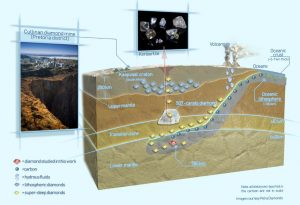A multidisciplinary and multiethnic team of scientists just published a paper in Nature where they explain the implications of having found calcium silicate perovskites contained within a tiny South African diamond.
The gem was dug from the Cullinan mine, located 40 kilometres east of Pretoria, where the world's largest rough diamond was found in 1905. The mine was also the source of two of the largest diamonds in the British Crown Jewels.
According to the researchers, CaSiO3 is the fourth most abundant mineral on Earth but only recently they were able to prove that it exists in a stable form, as it forms deep inside Earth’s mantle. Such confirmation, possible thanks to the fact that the mineral was trapped in an unyielding container, provided new insights into the processes that govern the planet’s interior.

The diamond discovered in a mine in South Africa contained perovskite, which meant it originated more than 700 km beneath Earth's surface. Photo by Petra Diamonds.
The authors of the paper, who ran X-ray and spectroscopy tests to confirm their suspicions, believe the perovskite-containing diamond likely formed some 700 km deep in the Earth and must have sustained 24 billion pascals of pressure, equivalent to 240,000 atmospheres.
“Based on our findings, there could be as much as zetta tonnes (1021) of this perovskite in deep Earth,” co-author Graham Pearson, who is a professor in the University of Alberta’s Department of Earth and Atmospheric Sciences, said in a statement. "The specific composition of the perovskite inclusion in this particular diamond very clearly indicates the recycling of oceanic crust into Earth’s lower mantle. It provides fundamental proof of what happens to the fate of oceanic plates as they descend into the depths of the Earth," he added.
Th scientific article also states that it is important to confirm the presence of calcium silicate perovskites deep in Earth because they are the dominant hosts for calcium and the major sink for heat-producing elements (potassium, uranium and thorium) in the transition zone and lower mantle.
“Diamonds are really unique ways of seeing what’s in the Earth,” Pearson concluded.
The post South African diamond provides new clues on Earth's internal processes appeared first on MINING.com....

